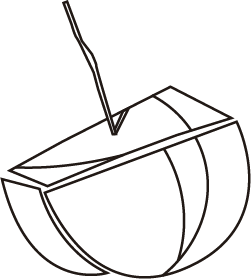BENIRRAMA'S CAVE PAINTINGS
 Benirrama’s cave paintings were discovered in 1977 by the Centre d’Estudis Contestans (Center for Contestani Studies), which studied the art they found and published works about it. The cave shelter is open towards the southeast, at the foot of the Sierra de L’Almirant and a few metres away from the Gallinera River.
Benirrama’s cave paintings were discovered in 1977 by the Centre d’Estudis Contestans (Center for Contestani Studies), which studied the art they found and published works about it. The cave shelter is open towards the southeast, at the foot of the Sierra de L’Almirant and a few metres away from the Gallinera River.
In the shelter of Benirrama there are two styles of rock art: schematic art and Levantine art.
Schematic art is a series of prehistoric representations, mostly painted and almost always within caves and shelters, that appeared in the Iberian Peninsula mostly associated with the first metallurgical cultures. The chronology behind this art is still a matter of debate, but it seems that it could be placed within the period going from the 4th to the 1st millennium BC. Its main feature, which gives it its name, is the schematism, that is to say that it is a figurative style in which only the basic elements of each figure are represented, eliminating all the others, thereby reducing the shapes to a few simple and basic lines.
Levantine art is present throughout the eastern part of the Iberian Peninsula, from Huesca and Lleida in the north to Andalusia in the south. The technique used is mostly red paint and exceptionally black and white paint and engraving. There are some figures made using thin lines which means an extraordinarily fine brush must have been used, perhaps a bird feather. It is characterised by using naturalistic images, in which animals, men and, to a lesser extent, women, become protagonists. They are often artworks associated with creating scenes with varied content, among which hunting predominates, along with others that evoke wars or everyday activities. Its dating has always been very controversial, but today there is absolute unanimity with regards to giving it a post-Paleolithic chronology, although there is no agreement between those who ascribe it to the Epipalaeolithic period and those who are inclined to including it definitely within the Neolithic period. More and more researchers are agreeing with the Neolithic proposal (6000-2500 BC).
In 1993, this shelter was subject to a severe case of looting. Two groups of figures were cut out with a circular saw and separated from the rock, where they had been for almost 6000 years. Another figure within the cave shelter was also ripped off with a lever. All in all, five figures disappeared.
The shelter is currently conditioned for visits, with panels explaining the painted motifs.
Thanks to a new path that has been designed to connect the two sites, it is now possible to hike along a thematic route regarding rock art, visiting this shelter and the other one near Benialí.
It is also possible to do a circular route that starts and ends in Benirrama.

Go to the information about Benirrama’s rock art route
Benirrama’s cave paintings were discovered in 1977 by the Centre d’Estudis Contestans (Center for Contestani Studies), which studied the art they found and published works about it. The cave shelter is open towards the southeast, at the foot of the Sierra de L’Almirant and a few metres away from the Gallinera River.









